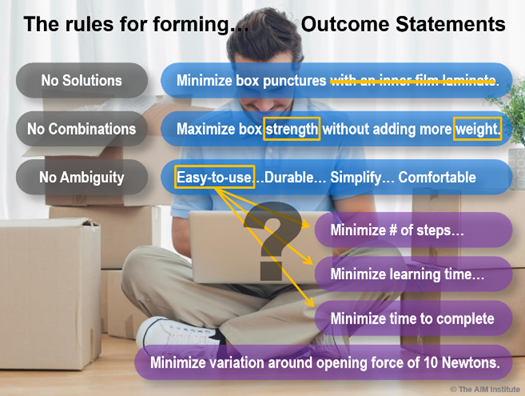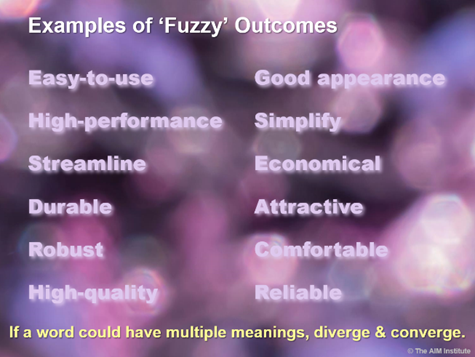Create stronger Outcome Statements with these rules... and clarify "fuzzy" outcomes.
You’ll find the entire New Product Blueprinting process goes better if you can create high-quality Outcome Statements while you’re still in the Discovery interview with your customers. Here are some “rules” to create the best possible Outcome Statements:

No Solutions: Don’t say, “Minimize box punctures with an inner film laminate.” Rather, your Outcome Statement should simply be, “Minimize box punctures.”
No Combinations: It’s a problem if your Outcome Statement is, “Maximize box strength without adding more weight.” If this scores a high Market Satisfaction Gap later, what will you work on? Higher strength? Or less weight? It’s hard to say. We understand that improving one outcome might degrade another. But the Blueprinting process will give you a way to prioritize these later. Besides, this is “solutions” thinking, and you need to stay in “outcomes thinking” during interviews.
No Ambiguity: Words and phrases like easy-to-use, durable, simplify, and comfortable are what we call “fuzzy outcomes.” They could mean different things to different people.

So what do you do when you hear a fuzzy word? Let’s say the customer said, “We’d like the box to be easy to open.” First you diverge to understand all their possible meanings. You might hear…
- Require fewer steps to open
- Require no tools to open
- Require less time to open
- Require less physical force to open
After you’ve diverged to all their possible meanings, you converge by asking, “Which of these is the most important to you?” The customer might say, “physical force.” Then you’d ask them if this outcome should be recorded in the header box of the sticky note: “MINIMIZE PHYSICAL FORCE NEEDED TO OPEN BOX.” It’s a good idea to ask them if their other possible outcomes are important enough to create separate notes for them.
For more on this topic, see e-Learning Module 16: Capturing Customer Outcomes at www.blueprintingcenter.com > e-Learning.
Keywords: customer outcomes, outcome statement, minimize, maximize, fuzzy outcome, ambiguous outcome, outcome statement rules, no combinations, no solutions, no ambiguity
